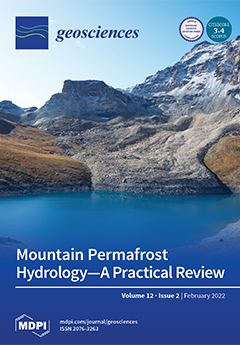The variations in assemblages of calcareous nannofossils are tracked in the Dakhla and Tarawan Formations exposed at Gebel Nezzazat (central Sinai, Egypt). Five calcareous nannofossil biozones, namely NP2/3, NP4, NP5, NP6, and NP7/8 are identified. A distinct marker bed related to the Latest
[...] Read more.
The variations in assemblages of calcareous nannofossils are tracked in the Dakhla and Tarawan Formations exposed at Gebel Nezzazat (central Sinai, Egypt). Five calcareous nannofossil biozones, namely NP2/3, NP4, NP5, NP6, and NP7/8 are identified. A distinct marker bed related to the Latest Danian Event (LDE) occurs within the Dakhla Fm. The earliest representative of fasciculiths,
Lithoptychius schmitzii, first occurs just below the LDE distinct bed and is followed by the Los of
Diantholitha alata,
D. mariposa,
L. varolii,
L. felis, and
L. collaris. The abundance of calcareous nannofossils drops within the LDE distinctive bed. The base of Selandian Stage is here approximated at the base of Zone NP5 in concurrence with a sudden drop in the abundance of calcareous nannofossils. No considerable lithological changes are noted across this transition. The absence of subsequent occurrences of
L. ulii,
L. janii,
L. billii, and
L. stegostus suggest inconsistent lowest occurrences (Los) of these taxa, insufficient sampling resolution, and/or a hiatus. The base of Thanetian is approximated with the base of Zone NP7/8 in the topmost of Dakhla Fm. No considerable changes in calcareous nannofossil assemblages are associated in correspondence to this transition except the LO of
D. mohleri, lowest continuous occurrence (LctO) of
Bomolithus megastypus, and the increase in abundance of
Heliolithus kleinpellii as well as a sudden drop in abundance within Zone NP7/8. The variations in calcareous nannofossil assemblages at Gebel Nezzazat suggest prevailing warm-water and oligotrophic conditions during the Paleocene and particularly along the Danian Stage that are interrupted by minor fluctuations in paleoclimatic conditions. In particular, the Danian–Selandian transition marks a decrease in warm and oligotrophic conditions that persisted along the Selandian Stage. The Selandian–Thanetian transition shows an increase of warm and oligotrophic conditions prevailed in the Thanetian record. The sudden decrease in abundance of calcareous nannofossils in both the Selandian and Thanetian is likely resulted from an increase in dissolution of carbonates rather than variations in the paleotemperature and/or paleofertility.
Full article





